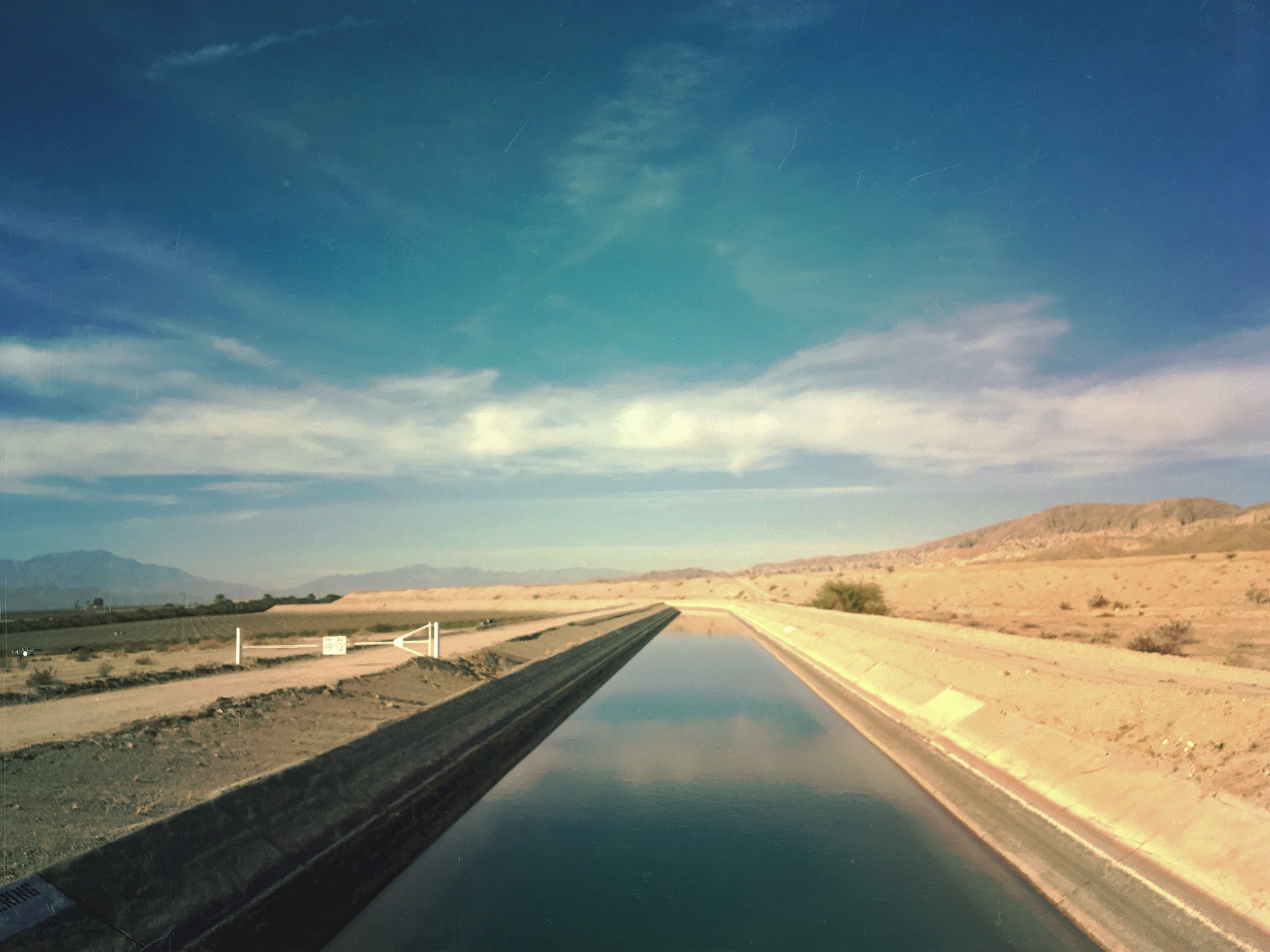JOSHUA TREE & SALTON SEA
We are in Joshua Tree. A massive terrarium of saguaro cacti, sagebrush and yuccas as far as the eye can see, where rock formations resemble giant, hunched orcs, and in the distance, a spiny ridge of mountains line the horizon. There is nothing quite like the colors of the desert here—a searing, blue-gold palette that scours the mind clean.
We roll through a nearby campground, where people have pitched tents and parked trailers in the shade of giant boulders. Climbers swathed in ropes and carabiners trudge past, crash pads cinched to their backs. Hikers bound from flat-topped boulders and become neon blips in the sagebrush. I look up and spy a woman in yoga regalia meditating on a sunny precipice.
Around the bend, there is a man standing on an outcropping. He is wearing a long, black trench coat (an odd choice for the sweltering, eighty-degree weather) and chain smokes as he glares down at passersby. I have a grim preoccupation with his strangeness, his unbelonging. Before I can stop myself, I imagine the dark barrel of an AR-15 poking out from beneath his mercenary-style cloak.
I make a face; send the thought away.
He is most likely doing nothing more than having a smoke as he exercises his right to wear climate-adverse clothes, but my mind has already run ahead, careening into unreality. These times are threaded with panic. The slightest snatch of headline pulls my heart into a knot.
It irks me that even here, in the heart of nature—a place that I have always found peace—I feel afraid. I’m fed up with this fear. I ask the desert sun to draw it out, burn it to chaff, to spirit it off on the wind.
*
We drive on until Joshua Tree peters out and we are bumping along the moonscape of the Mojave Desert.
When we drop into the Imperial Valley we are met by a dozen aptly-named washes—Smoke Tree Wash, Fried Liver Wash, Sy Wash, Fink Wash, Wister Wash, Sand Wash, Salt Wash, Gravel Wash, Bug Wash, Cat Tail Wash, Marshy Wash, Deep Wash.
The vineyards lining the valley are edged by colorful crops—orange and lemon groves, the ivory lace of almond trees, fields of red and green peppers.
We stop by the side of the road and I stand beneath a giant date tree. The scent of earth wafts from its trunk and my senses tunnel into the past—spring days in our Vashon Island garden, the sweet soil after a Midwestern rainstorm, Death Valley in August, when the tiniest wisp of wind is reason to rejoice.
As for the Salton Sea—it is a giant lake that was accidentally created in 1905 when irrigation canals were dug between the Colorado River and the Imperial valley. The waters flowed in steadily for two years, eventually creating the modern sea.
Today, the Salton Sea is fifteen miles wide and thirty-five miles long. It is the largest lake in California and is fed by the New, White Water, and Alamo rivers.
According to Wikipedia, its salinity “is greater than the Pacific Ocean but less than the Great Salt Lake.” The lake’s extremely high salinity started in the 1960’s. From then on, environmental harmony was lost; species began to die. Yet, its visage—a mist-covered plate of cobalt blue ringed by mountains—remains remarkably stunning.
We stop at the State Park and marvel that we are on the edge of a body of water that is two-hundred feet below sea level. I parry odd, nonsensical stabs of panic. How is the ocean not spilling over top of us? Drowning us like cereal in a bowl?
Further south, the community of Bombay Beach sits on the lake’s eastern shore. The name has a bright, exotic lilt. Yet, when we arrive, we find that it is essentially a ramshackle clutch of buildings cordoned inside a rectangle of piled-earth dikes.
We move slowly down the gravel streets, looking for signs of life. The town boasts 295 residents, but not a soul walks the streets. Where is everyone?
In lieu of tumbleweed or crickets, the whole place is shot through with the crumbled shells of houses—many charred and graffitied. Entire lots are filled with rusty trucks, cars with patchwork doors, mobile homes and RV’s that have seen better days. Fat, dry, headless palms edge the streets. And always, there is the come-and-go pinch of rotting fish on the breeze.
Finally, we spy movement—an old man walking out his front door. A few houses down, two women chat over a fence. A second man, on a bike with a banana seat and long, ape-hanger handlebars, veers toward us cartoonishly. Head cocked curiously, he stares at us as he passes. I wave. His eyes widen.
We leave oddly unsatisfied; unsure of what, exactly, we expected. We have seen a total of four people, which leaves only 291 Bombay Beach residents unaccounted for. What do they do? Where did they come from? What keeps them here?
Along the highway toward Niland, the road is a conga line of long-haul trucks. White, egret-ish birds tiptoe across the fields where migrant workers toil in leafy rows of kale, romaine, cilantro, and parsley.
We turn south and notice the large numbers of border patrol trucks.
“What are they doing up here?” We wonder aloud, ogling them as we pass. The men in the trucks look crisp and serious in their olive shirts and dark glasses, radios clipped to their sleeves.
Suddenly, we realize it’s we who are “down there”. We are skirting the city limits of Calexico, near the Mexican border. A very real part of us wants to keep going, to cross over. Go on the lam! Or at least, see the border from this side, from the ground. To envision how ugly and barbaric it would look to have a massive wall running the length of our countries.
We turn north on 86 and head for Kane Springs. Along the way, peeling billboards clamor: Salt-Free Water Vendor! Clean Dirt! Adult XXX Shop! Date Shakes! Hand-Delivered Gravel!
We reach Desert Shores where the remnants of giant canals still jut from the land. These are from the 1950’s and 60’s, when the lake was a haven for weekenders. At the height of its popularity, the Salton Sea was the desert’s version of Tahoe. It was where the party started and stayed.
There had been grand plans, once to build it so that more would come. It was to be the ultimate utopia of seaside resorts and marinas, a lake full of zipping speed boats and fishing fanatics! But in the end, stagnant waters would not sell. The failure of man-crafted nature and ultimately, the death of the fish, made it all fizzle.
We roll through what’s left. Down by the water, furniture is strewn around a fire pit. The sun sets across a rocky lot where cats patrol the ditches. Across the way—the busted, concrete facade of “Our Place Saloon” stares out like a bewildered, fist-punched face.
On the back wall of the still-operating MoneyGram building, however there is a surprise—the black and white mural of a woman entwined with rattlesnakes. Or, perhaps she is the rattlesnake? Whomever is what, and whatever it means, it’s a breath-taking piece of art.
We pull away from Desert Shores and I think about how the loneliest, left-behind things are beautiful simply because they exist where other things no longer do. These are the Toughs and Hold-Outs—people and places unconcerned with what the outside world makes of them.
The drive has taken over half a day. As we drive north, the peach sky washes into a fertile blue. On the Salton Sea’s western shore, stanchions of palms ripple beneath a pinprick of white moon—a picture postcard of a desert oasis thriving beyond the limits of civilization. Or, the border of a lost kingdom, a disappeared dream.
Hoped for, done and gone.














